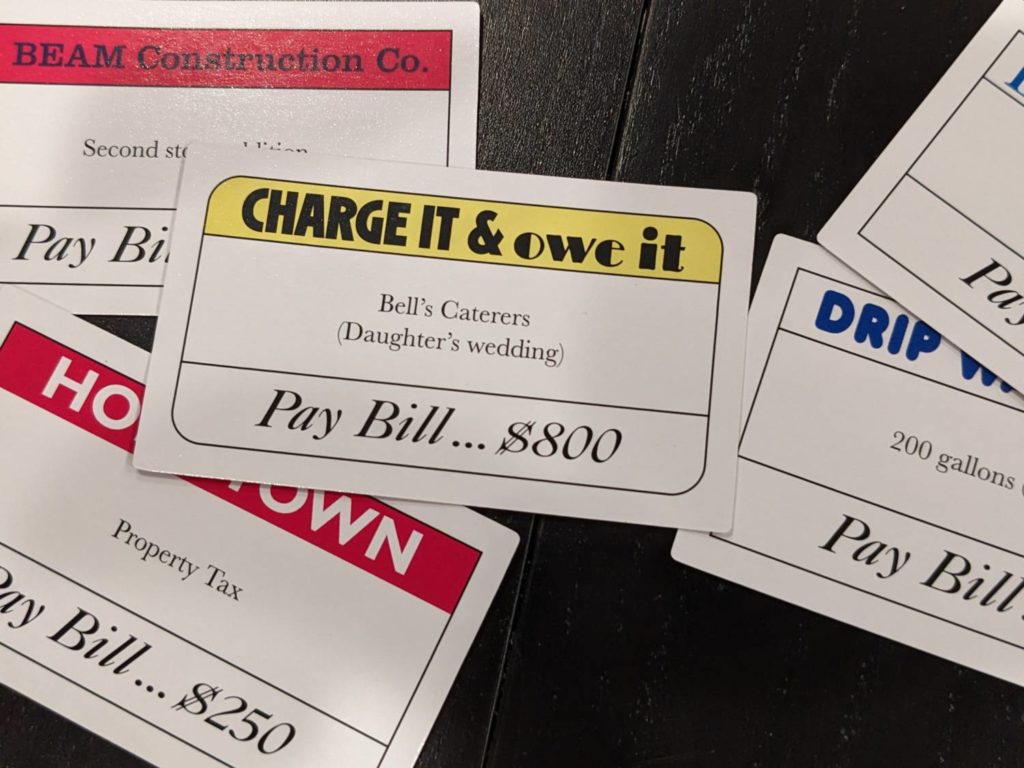It was on the kitchen table for the third time in a week.
My son had already set up the game Pay Day (1975, Parker Brothers). That meant we were gonna run around that classic board—it’s a calendar of a 31-day month—and try to avoid all the bad things that can happen.
As Pay Day approaches its golden anniversary, I wanted to revisit this game to see how it lands. In our “Back in the Day” series, Meeple Mountain team members will revisit old games from their collection to see how they have aged. We will focus solely on what works with each game, and what does not, before offering a verdict on whether these games should stay in our personal collections.

Pay Day: What Still Works?
Roll dice, move forward, read the text on the space.
For almost any adult, teaching Pay Day is still a piece of cake. But even better, it’s an incredible teacher for the realities of living an adult life. Paying bills, managing cash flow, putting money into savings so that you can increase the amount of money you make in interest, and making good investments with your money.
All of that still works well in Pay Day. Remember the episode from The Cosby Show when Cliff shows Theo how to manage expenses using Monopoly money? After talking about rents for a New York City apartment, and later reminding Theo that he hasn’t accounted for food yet, the exchange ends with one of my favorite TV moments ever.
Cliff: “You plan to have a girlfriend?”
Theo: “For sure!”
[Cliff takes the last $200 from Theo’s hands.]
I’ve already used Pay Day a few times to help the kids to understand what it looks like when you have to pay for speeding tickets, home repairs, or other surprises—when you budget, you have to also plan for those moments in life that you were NOT expecting, like a random $500 plumbing bill.
(You’re right: getting paid $325 a month, the original game’s monthly income, is not gonna work in today’s America. But my kids don’t know that, so they think that $325 is a ton of cash. Keep living the lie, parents!)
It is still fun to buy a Deal for $200 and then land on a Buyer space to sell that Deal for $550. The game’s best Deal card is undoubtedly the “Two Acres, Vacationland” card, which costs $1,000 and nets $2,500 if you can land on a Buyer. In every game of Pay Day played at my house last year, the person who bought that card won. But buying a Deal is always a risk—what if you never land on a Buyer?
That tension still exists, and it still makes the game fun. Tracking loans versus savings also allows for my kids to get a sense of what it is like to take on more economic stress than necessary. That’s why rolling a six when the pot is full (from Town Election and “Swellfare” fees) is always such a great moment.

Pay Day: What Doesn’t Work?
A game where you have to roll a six-sided die to move forward on the board is going to turn off many core gamers. Totally fine for family game nights over the holidays, but I can already hear the groans from strategy gamers used to having more control over the outcome.
In Pay Day, sometimes the die rolls will work out and you’ll land on the Inheritance space ($500!!), or maybe you will land on the spaces where you only take one piece of mail, and not three. (Remember, in Pay Day, if you never go to the mailbox, you never get any bills. Life before the Internet was amazing.)
Sometimes, you get comically unlucky, and hit all of those three-mail spaces, get all the big bills, and stop on every single board space that forces you to pay out of pocket for minor costs like groceries or home repairs. It can be rough.
The final game of Pay Day that we played in 2022 finished with my son having more than $5,000, my daughter finished with about $4,800, and I had a $700 loan to end the game after six months.
Yeah.
Pay Day has paper money, which I still don’t love, but it does bring the nostalgia of all those games of Pay Day from my youth. It’s a pain to play as the banker, but someone has to eat that bullet every game. A six-round game takes about 90 minutes, and Pay Day has one of the worst runaway leader issues in gaming history (easier to say with 47 years of games behind it!). Thanks to the Deal system, catching up to a player who has landed a couple of the $2,500 Deals is impossible.

Yea or Nay?
Now, even though I love playing Pay Day because it brings back so many funny memories, it is impossible to recommend. It takes too long to play, relies too much on chance, and does ridiculous things like force a player to potentially buy a new dress for the high school dance every single month. (It’s an actual space on the board!)
But I am loving the lessons that Pay Day teaches my kids. Watching my daughter carefully consider how much money to add to her savings account at the end of each month is great. My son is never sure about those Deals that net less profit than you pay into them. As a parent, you can do a lot worse than Pay Day when it comes to a teaching tool. In fact, the game counters well against all the dungeon crawler games where the kids play opportunists most concerned with their loot haul.
I found my copy of Pay Day at Target a few years ago. It’s a part of the “Retro Series” from Hasbro Gaming that included games in their original form, with the same cover art and iconography from the oldest versions. The game hasn’t aged that well, but I’m still OK with owning the 23,600th-ranked game on BGG!!
The Back in the Day Series:










